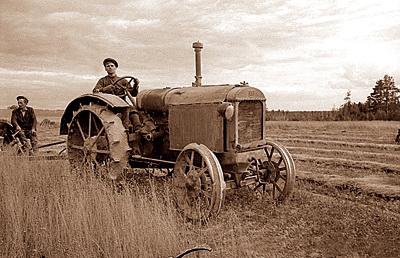In the late 1920s and early 1930s, in the USSR, on the initiative of the All-Union Communist Party of Bolsheviks, mass collectivization took place in rural settlements. The process of collectivization and the creation of large agricultural enterprises of the socialist type was hindered by the lack of material and technical base in the countryside. The peasants were not interested in working for a state that uses the physical labor of people, giving virtually no pay for it.
What is MTS in the USSR?
In 1929, at the 15th congress, the parties analyzed the situation in the country's agriculture. The party leadership once again emphasized that it is necessary to create large-scale agricultural production in the countryside so that the city is provided with bread, cereals and other products. Understanding that the state should provide equipment to newly created collective enterprises to reduce the share of non-mechanized production processes, Stalin positively assessed the work of the first MTS. By the way, what is the abbreviation MTS for decryption? The USSR created machine-tractor stations, which were abbreviated as MTS.
History of the creation and development of machine and tractor stations
The first machine and tractor station in the Union was created in 1927. The place of creation is the village of Shevchenkovo, Odessa region, Ukraine. By the way, this is no coincidence, because the Odessa region has always been famous for its abundance of rationalization ideas, which almost immediately after their implementation showed their effectiveness and yielded real tangible results. At the above congress, the party positively assessed the activities of the first Soviet MTS.
Stalin saw in the development of the network of tractor stations one of the foundations for the implementation of the party concept of collectivization in agriculture. The task set by the congress to the leaders of the agricultural sector was to actively cover the tractor equipment of the whole country with the service station system. Many party employees personally (there was an excursion) saw what MTS is. In the USSR, the number of such enterprises in 1931 amounted to 1228. Since the rate of collectivization was growing (1932 was the peak of the formation of collective farms), it was necessary to create new technical enterprises. Analyzing the statistical data for 1933, we see a more than double increase in the number of MTS (up to 2886), and in 1934 the state opened about 500 more stations. The party leadership was also not going to stop at this, so the next task was set. In 1937 (and we all know what time it was) the number of stations was supposed to be 6,000. Of course, the result was achieved, because during the years of mass repression and the heyday of denunciations, the failure to comply with party directives was often punished by camps or execution.

The order of interaction of MTS and collective farms
What is MTS in the USSR for the collective farms themselves? On each collective farm, leaders also saw the need for mechanization of labor, because it led to an increase in labor productivity and crop yields. Without their own equipment, the collective farms represented by MTS saw support from the state.
How was the collaboration organized? The machine and tractor station owned machinery, the production of which was also constantly growing. Tractors, combines and other equipment were leased to collective farms. Collective farms paid MTS the cost of renting equipment from the money that they received for the delivery of the harvest to the state. In the event of a breakdown of the tractor, the combine harvester, the seeder, the mechanics of the MTS came to the collective farm on call, examined the equipment and repaired it.
The political aspect of MTS
In the 1930s, any economic activity was directly related to political issues. Each tractor station had a political department, headed by a deputy director for political work. The tasks of the department included the management of the party organizations of MTS and the collective farms attached to it. Responsibility for the quality work of MTS was borne not only by the director, but also by the political department. This is not surprising, because any failure in the operation of the economic mechanism in those years was regarded as sabotage, and this was already on the political side.
What is MTS in the USSR, now, we hope, is clear to everyone. Without a technical foundation, collectivization would most likely be impossible.